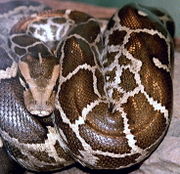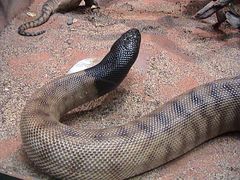Pythonidae
| Pythonidae | |
|---|---|
 |
|
| Indian python, Python molurus | |
| Scientific classification | |
| Kingdom: | Animalia |
| Phylum: | Chordata |
| Subphylum: | Vertebrata |
| Class: | Reptilia |
| Order: | Squamata |
| Suborder: | Serpentes |
| Infraorder: | Alethinophidia |
| Family: | Pythonidae Fitzinger, 1826 |
| Synonyms | |
|
|
The Pythonidae, commonly known simply as pythons, from the Greek word python-πυθων, are a family of non-venomous snakes found in Africa, Asia and Australia. Among its members are some of the largest snakes in the world. Eight genera and 26 species are currently recognized.[2]
Contents |
Geographic range
Found in subsaharan Africa, India, Myanmar, southern China, Southeast Asia and from the Philippines southeast through Indonesia to New Guinea and Australia.[1]
In the United States an introduced population of Burmese pythons, Python molurus bivittatus, has existed as an invasive species in the Everglades National Park since the late 1990s.[3]
Conservation
Many species have been hunted aggressively, which has decimated some, such as the Indian python, Python molurus.
Behavior

Aspidites melanocephalus
Most members of this family are ambush predators, in that they typically remain motionless in a camouflaged position and then strike suddenly at passing prey. They will generally not attack humans unless startled or provoked, although females protecting their eggs can be aggressive. Large adult specimens can kill people. Unsuspecting children can and have been preyed upon and swallowed whole after being suffocated. Reports of attacks on human beings were once more common in South and Southeast Asia, but are now quite rare.
Feeding
Prey is killed by a process known as constriction; after an animal has been grasped to restrain it, a number of coils are hastily wrapped around it. Then, by applying and maintaining sufficient pressure to prevent it from inhaling, the prey eventually succumbs due to asphyxiation. It has recently been suggested that the pressures produced during constriction cause cardiac arrest by interfering with blood flow,[4] but this hypothesis has not yet been confirmed.
Larger specimens usually eat animals about the size of a house cat, but larger food items are not unknown: some large Asian species have been known to take down adult deer, and the African rock python, Python sebae, has been known to eat gazelle. Prey is swallowed whole, and may take anywhere from several days or even weeks to fully digest. Despite their intimidating size and muscular power, they are generally not dangerous to humans.
Contrary to popular belief, even the larger species, such as the reticulated python, P. reticulatus, do not crush their prey to death; in fact, prey is not even noticeably deformed before it is swallowed. The speed with which the coils are applied is impressive and the force they exert may be significant, but death is caused by suffocation, with the victim not being able to move its ribs to breathe while it is being constricted.[5][6][7]
Reproduction
Females lay eggs (oviparous). This sets them apart from the family Boidae (boas), most of which bear live young (ovoviviparous). After they lay their eggs, females will typically incubate them until they hatch. This is achieved by causing the muscles to "shiver", which raises the temperature of the body to a certain degree, and thus that of the eggs. Keeping the eggs at a constant temperature is essential for healthy embryo development. During the incubation period, females will not eat and only leave to bask to raise their body temperature.
Captivity
Most species in this family are available in the exotic pet trade. However, caution must be exercised with the larger species as they can be dangerous; cases of large specimens killing their owners have been documented.[8]
Genera
| Genus[2] | Taxon author[2] | Species[2] | Subsp.*[2] | Common name | Geographic range[1] |
|---|---|---|---|---|---|
| Antaresia | Wells & Wellington, 1984 | 4 | 0 | Australia in arid and tropical regions. | |
| Apodora | Kluge, 1993 | 1 | 0 | Papuan python | Most of New Guinea, from Misool to Fergusson Island. |
| Aspidites | Peters, 1877 | 2 | 0 | Australia except in the south of the country. | |
| Bothrochilus | Fitzinger, 1843 | 1 | 0 | Bismark ringed python | The islands of the Bismark Archipelago, including Umboi, New Britain, Gasmata (off the southern coast), Duke of York and nearby Mioko, New Ireland and nearby Tatau (off the east coast), the New Hanover Islands and Nissan Island. |
| Leiopython | Hubrecht, 1879 | 1 | 0 | D'Albert's water python | Most of New Guinea (below 1200 m), including the islands of Salawati and Biak, Normanby, Mussau, as well as a few islands in the Torres Strait. |
| Liasis | Gray, 1842 | 3 | 2 | Indonesia in the Lesser Sunda Islands, east through New Guinea and in northern and western Australia. | |
| Morelia | Gray, 1842 | 7 | 5 | From Indonesia in the Maluku Islands, east through New Guinea, including the Bismark Archipelago and in Australia. | |
| PythonT | Daudin, 1803 | 7 | 4 | Pythons | Africa in the tropics south of the Sahara (not including southern and extreme southwestern Madagascar), Bangladesh, Pakistan, India, Sri Lanka, the Nicobar Islands, Myanmar, Indochina, southern China, Hong Kong, Hainan, the Malayan region of Indonesia and the Philippines. |
*) Not including the nominate subspecies.
T) Type genus.[1]
Taxonomy
Pythons are more closely related to boas than to any other snake-family. Boulenger (1890) considered this group to be a subfamily (Pythoninae) of the family Boidae (boas).[1]
Gallery
 Carpet python, |
 Green tree python, |
 Albino Burmese python, |
 Borneo short-tailed python, |
See also
- List of pythonid species and subspecies
- Pythonidae by common name
- Pythonidae by taxonomic synonyms
- List of snakes, overview of all snake families and genera.
- Python (mythology), the oracular serpent of Delphi
References
- ↑ 1.0 1.1 1.2 1.3 1.4 McDiarmid RW, Campbell JA, Touré T. 1999. Snake Species of the World: A Taxonomic and Geographic Reference, vol. 1. Herpetologists' League. 511 pp. ISBN 1-893777-00-6 (series). ISBN 1-893777-01-4 (volume).
- ↑ 2.0 2.1 2.2 2.3 2.4 "Pythonidae". Integrated Taxonomic Information System. http://www.itis.gov/servlet/SingleRpt/SingleRpt?search_topic=TSN&search_value=563893. Retrieved 15 September 2007.
- ↑ Huge, Freed Pet Pythons Invade Florida Everglades at http://news.nationalgeographic.com/news/ National Geographic News. Accessed 16 September 2007.
- ↑ Hardy, David L. (1994). A re-evaluation of suffocation as the cause of death during constriction by snakes. Herpetological Review 229: 45-47.
- ↑ Mehrtens JM. 1987. Living Snakes of the World in Color. New York: Sterling Publishers. 480 pp. ISBN 0-8069-6460-X.
- ↑ Stidworthy J. 1974. Snakes of the World. Grosset & Dunlap Inc. 160 pp. ISBN 0-448-11856-4.
- ↑ Carr A. 1963. The Reptiles. Life Nature Library. Time-Life Books, New York. 192 pp. LCCCN 63-12781.
- ↑ The Keeping of Large Pythons at Anapsid. Accessed 16 September 2007.
External links
- Boidae at the Reptarium.cz Reptile Database. Accessed 3 November 2008.
- Pythons (Pythonidae) at Answers.com. Accessed 3 November 2008.
|
|||||||||||